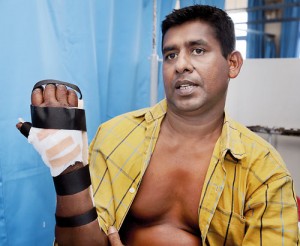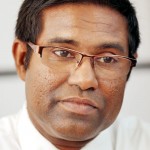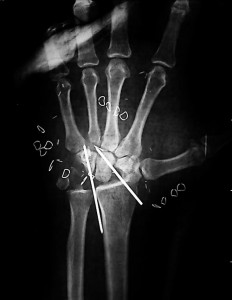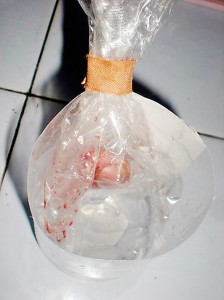To hold up a hand that’s whole again
View(s):Henagama Liyanage Ranjith Dayananda is a happy man now and there’s jubilation at the Kalubowila Hospital following the first full-hand re-implantation being performed there. Kumudini Hettiarachchi reports on this medical feat.
Excruciating pain as he recoils and hurriedly pulls out his hand from the machine, blood spurting all over.
Realization only dawns as Henagama Liyanage Ranjith Dayananda, 45, looks down in shock and horror – there is only a stump of mangled flesh and shattered bone where his right hand should have been. That was on March 24.

Ranjith relieved to have his hand back. Pix by M.A. Pushpa Kumara
About a week short of a month, however, there are only smiles and huge relief when we meet Ranjith on Thursday (April 16). Holding up his arm, while seated on his hospital bed, he gently moves his fingers to show us that all seems well.
Not only has the hand been re-implanted but there is also strong hope that it would be functional, as if an Avurudu blessing has been showered on the Dayananda family.
This medical feat has been achieved by the prompt and skilful intervention from the moment that Ranjith was rushed to the Colombo South (Kalubowila) Teaching Hospital.
There is jubilation at the Kalubowila Hospital because this is the first full-hand re-implantation performed here even though difficult finger re-implants have been carried out earlier.
“It was complex surgery because it was an ‘avulsion’ injury,” says Consultant Plastic and Reconstructive Surgeon, Dr. Yasas Abeywickrama, explaining that unlike a ‘clean-cut injury’, there was much damage because the hand had been torn apart.
Before Dr. Abeywickrama delves into the intricacies of the nearly 11-hour operation, Ranjith relives that fateful day. Coming to work at a factory dealing with rubber products at Dehiwela from his home in Wadduwa, Ranjith who usually is in the workshop had been asked to clean a newly-installed machine. It was a machine which crushes discarded rubber, making it turn into rubber-dust. It was when he put his right hand to “take out the kudu” that may have been left inside the machine that it had been switched on and there was a “dadang gala saddayak ahuna”, says Ranjith, adding that at the same time he felt a strange “sahalluwak”. (There was a big noise, after which he felt light.)
As Ranjith pulled his hand from the machine, he was shocked to find that only a bloody stump remained at the wrist. Squeezing the flesh tightly, his co-workers then rushed him to the Accident Service of the Kalubowila Hospital, with one close friend, Eranga, reassuring him not to be scared.
When brought to the Kalubowila Hospital, it was the Accident Service Surgical Team headed by Dr. Asela Jayathilaka which got into action and

Dr. Yasas Abeywickrama
performed initial resuscitation, stopping the bleeding from the stump. As those who rushed Ranjith to hospital had not brought the severed hand which was still inside the machine, immediate instructions had been given on the right manner in which to bring the beleaguered limb as soon as possible to facilitate a re-implant, the Sunday Times learns. (See box)
In the case of Ranjith, the company staff had broken the machine and “rescued” the hand from within and brought it in a ‘cool box’.
Assessed by the Anaesthetist Team, Ranjith had then been taken to the main operating theatre (OT) where the Plastic Surgical Team headed by Dr. Abeywickrama set to work to re-implant the hand, after explaining to Ranjith all about the procedure before he was put to sleep under general anaesthesia.
Referring to the lack of facilities for plastic surgery including an OT and a ward, which Kalubowila Director Dr. Asela Gunawardena is striving hard to overcome by mobilizing the new building which has been stuck in controversy, Dr. Abeywickrama is quick to point out that when they needed the main OT for Ranjith, Consultant General Surgeon, Dr. A. Kailanathan, finished up his surgical list quickly to make room for this emergency. The OT staff too got into gear in no time without a grumble but much enthusiasm, while the Plastic Surgical Team scrubbed up.
Then began the re-attachment of the hand, after the sleeping Ranjith had been injected with protective (prophylactic) antibiotics to prevent infection.

The X-ray of the severed hand
Cleaning not only the hand but also the forearm stump, Dr. Abeywickrama and his team carried out thorough debridement of the contaminated tissue, removing all the foreign bodies embedded in them. Throughout the procedure, for all of more than 10 hours, by the side of Dr. Abeywickrama had been Surgical Registrar Dr. Hasith Wijayasurendra.
Assessment of each and every tissue injury followed sequentially, with the distal stump and the proximal part being dissected under magnification to identify individual tissue components, the Sunday Times learns. Bone, ligaments, tendons, arteries, veins and nerves, the team examined.
“We removed the proximal row of carpal bones not only because they were badly damaged but also to reduce tension on vascular repair,” says Dr. Abeywickrama, after which these bones were fixed to the radius and ulna.
Next they performed the repair of the ligaments of the wrist joint as well as two arteries (radial and ulnar), along with three veins under microscopic surgery. “We used the Eye Surgeon’s microscope because we don’t have a plastic one but are awaiting its arrival,” says Dr. Abeywickrama.
As the venous drainage was not adequate, a vein from the calf of the leg was used for a vein graft, followed by the repair of the flexor and extensor tendons and the repair of the three major nerves (median, ulnar and radial) of the hand.
Thereafter, the team covered the soft tissue with the available skin-flaps, utilizing skin from the thigh as grafts for three areas. The final touch was stabilizing the re-implantation with a light dressing and a supportive splint.
“While the major challenge in such a re-implantation is blood vessel anastomosis (surgical connection), the target is to carry out a complete repair for the limb to be properly functional,” says Dr. Abeywickrama not only paying tribute to all those who helped make the surgery a success but also to Director Dr. Gunawardena who has provided the state-of-the-art microsurgery instruments and is ever-willing to support the improvement of patient care in any way possible.
After the re-implantation, it was a stay in the Surgical Intensive Care Unit (SICU) and then a transfer to Ward 26 where Ranjith has been and is being looked after with much care and concern.
The hand-replant team headed by Dr. Abeywickrama included Surgical Registrar Dr. Hasith Wijayasurendra, Dr. Amith Kularathna and Dr. Preethi Perera; the anaesthetist team headed by Consultant Anaesthetist Dr. Mala Nanayakkara included Registrar Dr. Damith Tharanga Silva, Dr. Anusha Sigarajasingham, Dr. Shivaruby Selvanathan, Dr. Priyanka Bandara, Dr. S. Shanmugadas and Dr. S. Suwendran; the nursing team included Chami Kandauda, Chamila Priyadarshani, Nimanka Peiris, M.P.J.C.S. Ariyarathna, N. Weerasiri, H.A.R. Lakmali, W.M.D. Chandani and K.G.M. Priyanthi; and the supportive staff comprised Mahesh Priyantha, L.P.A.S.N.R. Senevirathna and P.A. Suranga.
We leave Kalubowila Hospital, with Ranjith, his wife, Himali Dilrukshi Perera, and two sons murmuring blessings on the doctors and nurses who have given them hope against much despair. This is while Ranjith and family will have to have absolute commitment to see through the long follow-up of hand-therapy vital to get the limb functioning.
Dr. Abeywickrama and his team, meanwhile, consider it their bounden duty, nay calling, to do the work they do with all the passion, vigour and skill they can muster.
When the nearly 11-hour marathon from 3 in the afternoon to about 2 the next morning, was over, while the world around them was deep in slumber but they were dog-tired and sleepy, there was only euphoria.
“Great joy,” is how Dr. Abeywickrama describes his feelings when after they had accomplished this surgical mission, they saw that all the fingertips of Ranjith’s newly re-implanted right hand were pink.
| Accident prevention should be a priority Prevention of accidents is always better and needs to be given priority, is Dr. Yasas Abeywickrama’s motto. His advice to all those handling machines is: - When working with machinery, be aware how it operates. It is a necessity for anyone operating a machine to have an orientation programme before being deployed at the machine. - When repairing or checking the insides of the machine, make sure that the power is switched off. If there are several people involved in this process, there has to be good communication among all, to ensure that someone does not switch on the machine while another is handling it. - The ‘safety mechanisms’ of any machine should never be removed to make the production-line faster as it would bring about disastrous consequences and cause accidents even among veteran operators. All those operating machinery, apprentice or veteran, should give their full attention to it, without getting distracted.
How best to transport severed limbs Explaining the Do’s and Don’ts in transporting a severed limb to give the best chance at re-implantation, Dr. Yasas Abeywickrama says: - The limb needs to be transported under dry conditions as soon as possible, ideally within six hours, along with the patient to hospital. - Put the limb in an empty polythene bag, then place the polythene bag in a box and surround the polythene bag with plenty of ice-cubes. - The severed limb should not be in direct contact with the ice as there would be frost-bite. - The severed limb should also not be tightened or squeezed. - Do not insert the severed limb in saline, milk, water or any otherliquid, as such solutions will damage the intima (inner layers) of the blood vessels, making them prone to thrombosis (causing blood clots). Dr. Abeywickrama also underscores the importance of informing the hospital in advance when a victim of any such limb injury is being brought there, so that all the relevant multidisciplinary teams could be on standby for the victim’s arrival. |



